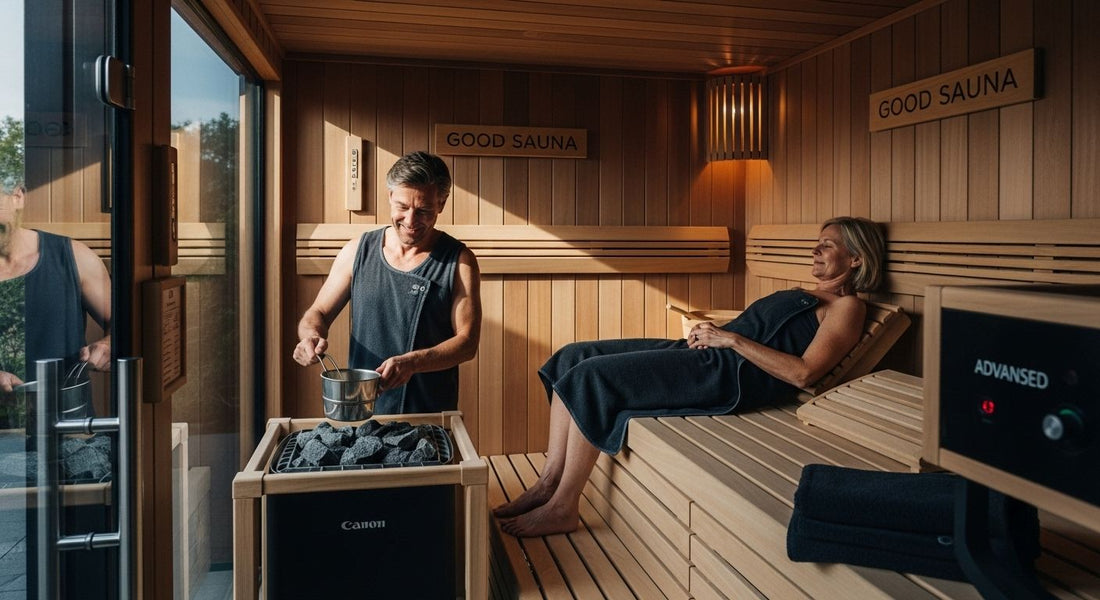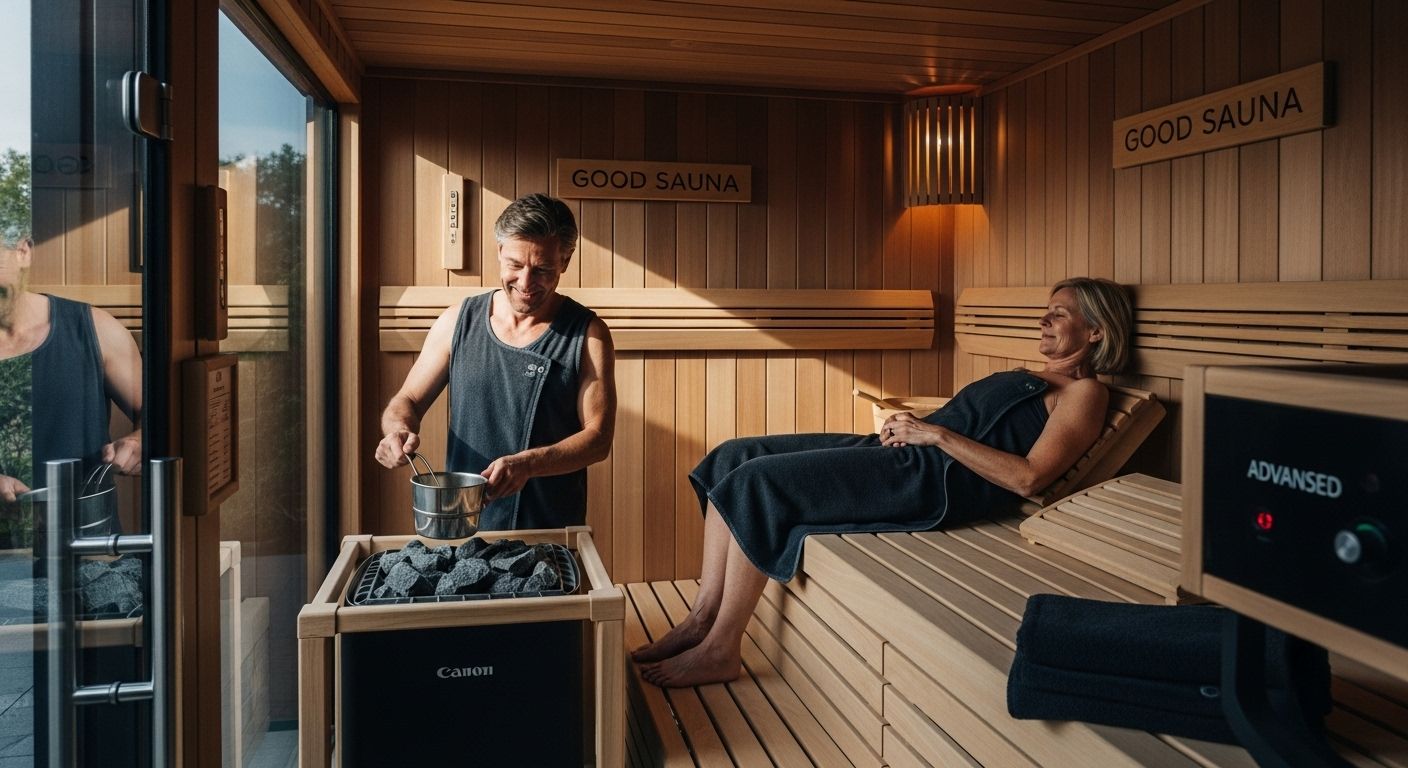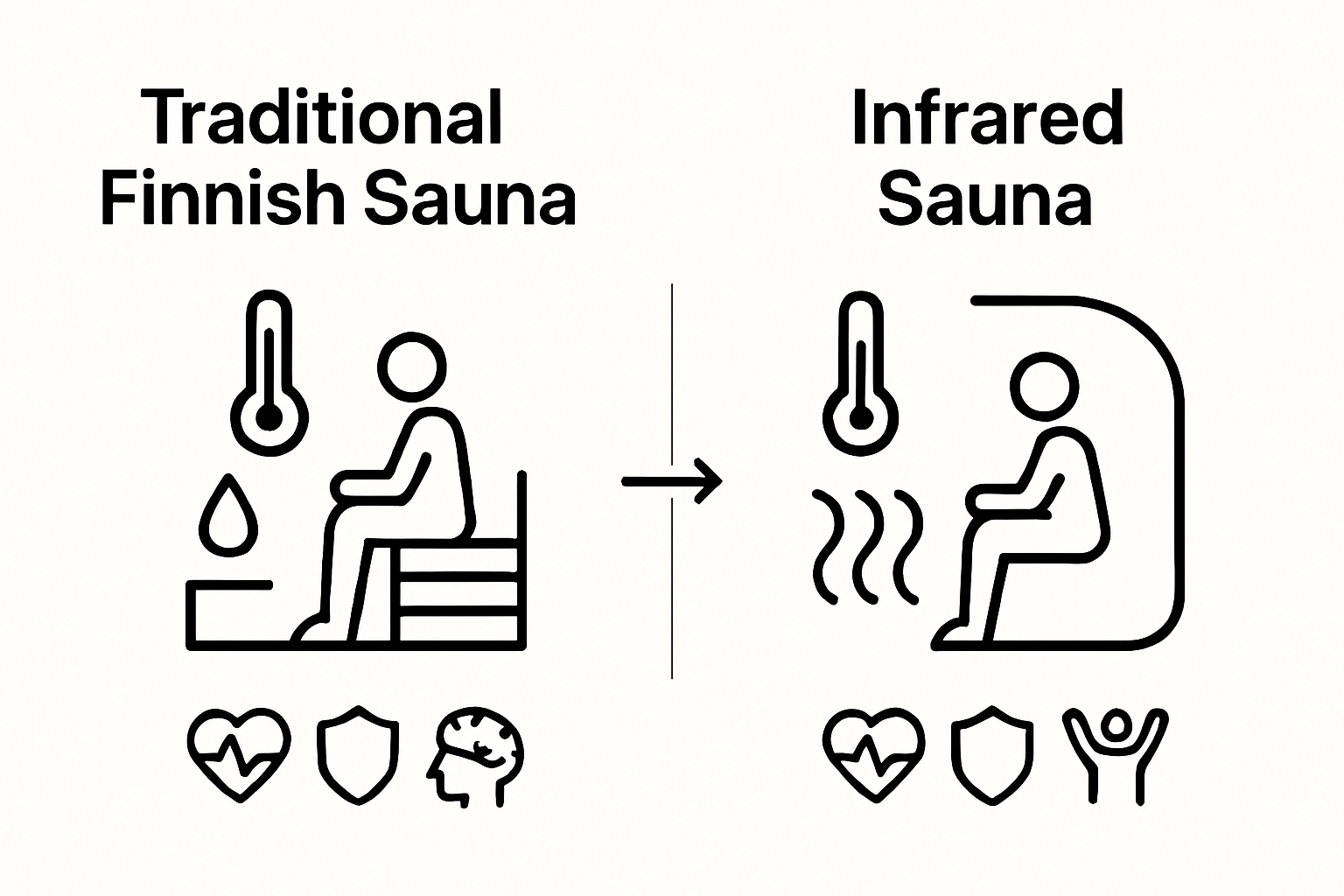
Understanding What Makes a Good Sauna for Wellness

Most people think of a sauna as a simple hot room for relaxing muscles and detoxing sweat. Turns out that is only half the story. Saunas engineered for wellness can actually drive cardiovascular benefits on par with moderate exercise and some studies show heart rates in a proper sauna can climb just like a 30-minute jog. So a good sauna is not just about turning up the heat. The design, materials, and temperature precision might be doing far more for your health than you ever imagined.
Table of Contents
- Defining Sauna: What Is A Good Sauna?
- The Importance Of Sauna Quality: Why It Matters
- Types Of Saunas: How They Work And Their Benefits
- Key Features Of A Good Sauna: What To Look For
- Real-World Benefits: How A Good Sauna Enhances Well-Being
Quick Summary
| Takeaway | Explanation |
|---|---|
| Quality Materials Matter | Construct saunas using natural, heat-resistant woods like cedar for safety and durability. |
| Control Temperature Precisely | Maintain sauna temperatures between 80-106°C to ensure effective and safe heat exposure. |
| Prioritize Ventilation | Effective air circulation is crucial for consistent heat and safety inside the sauna. |
| Understand Sauna Types | Different saunas, like traditional and infrared, offer unique benefits tailored to user needs. |
| Regular Use Supports Wellness | Consistent sauna usage enhances cardiovascular health, reduces stress, and promotes relaxation. |
Defining Sauna: What is a Good Sauna?
A sauna represents more than just a heated room for relaxation. It is a carefully designed wellness environment engineered to promote physiological and psychological healing through controlled heat exposure. Understanding what makes a good sauna involves examining its core characteristics, design principles, and potential health benefits.
Core Components of an Excellent Sauna
A high-quality sauna is not merely about generating heat but creating an optimal therapeutic environment. According to Mayo Clinic Proceedings, an exceptional sauna should possess several critical attributes:
- Temperature Control: Precise regulation between 80-106 degrees Celsius
- Material Quality: Construction using natural, heat-resistant materials like cedar or hemlock
- Ventilation System: Efficient air circulation ensuring consistent heat distribution
The fundamental goal of a superior sauna transcends simple warming. It aims to induce controlled physiological responses that stimulate cardiovascular function, enhance cellular repair mechanisms, and support overall wellness.
Health-Focused Design Considerations
What distinguishes a good sauna from an average one is its intentional design focused on user health. Modern wellness-oriented saunas integrate scientific understanding of human thermal response. As research from the American Journal of Medicine demonstrates, an excellent sauna should accommodate individual physiological differences while maintaining safe, therapeutic heat exposure.
Key design elements include ergonomic seating, humidity management, and thoughtful heat gradient configurations that allow users to experience progressive thermal adaptation. The most effective saunas create an environment that challenges the body’s thermoregulatory systems without overwhelming them, promoting natural stress response and recovery mechanisms.
Beyond Heat: A Holistic Wellness Experience
A truly exceptional sauna transforms from a simple heated space into a comprehensive wellness platform. It should provide not just heat, but a carefully curated environment that supports mental and physical rejuvenation. This means considering factors like acoustic design, lighting, and potential integration with other recovery modalities.
Ultimately, what makes a good sauna is its ability to harmonize advanced thermal technology with human physiological needs, creating a therapeutic space that supports holistic health and personal wellness goals.
The Importance of Sauna Quality: Why It Matters
Sauna quality is not a luxury but a critical factor determining the effectiveness and safety of your wellness experience. The precision of design, materials, and thermal engineering directly impacts the physiological responses and potential health benefits you can derive from sauna sessions.
Scientific Foundations of Sauna Quality
Quality in saunas goes far beyond aesthetic appeal. According to Harvard Health, the intricate details of sauna construction profoundly influence its therapeutic potential. A superior sauna must meticulously balance several scientific parameters:
- Thermal Consistency: Uniform heat distribution preventing cold spots
- Material Thermal Conductivity: Optimal heat retention and transfer
- Humidity Management: Precise control of moisture levels
These technical considerations ensure that the sauna can effectively stimulate the body’s natural healing mechanisms, triggering beneficial physiological adaptations.
Health Risk Mitigation Through Quality Design
Poorly constructed saunas pose significant health risks. Quality becomes a critical safeguard against potential adverse reactions. Substandard saunas might introduce uneven heating, inadequate ventilation, or material off-gassing that could compromise user safety.
A well-engineered sauna creates a controlled environment that challenges the body’s thermoregulatory systems safely. This means maintaining appropriate temperature gradients, ensuring proper air circulation, and using non-toxic, heat-resistant materials that do not degrade under intense thermal conditions.
Comprehensive Wellness Investment
Viewing sauna quality as an investment in personal health reframes the entire purchasing perspective. High-quality saunas are not expensive accessories but sophisticated wellness technologies designed to support long-term physiological and psychological well-being.
The most advanced saunas integrate cutting-edge thermal engineering with ergonomic design, transforming a simple heated space into a precision instrument for personal recovery, stress management, and holistic health optimization. Quality determines not just comfort, but the depth and reliability of potential health benefits you can experience through regular sauna use.
Types of Saunas: How They Work and Their Benefits
Saunas are not a monolithic wellness experience but a diverse range of thermal therapy technologies, each offering unique physiological interactions and health benefits. Understanding the distinct characteristics of different sauna types allows individuals to select the most appropriate therapeutic approach for their wellness goals.
Traditional Finnish Sauna: The Classic Heat Experience
Traditional Finnish saunas represent the gold standard of thermal wellness, characterized by high temperatures and low humidity. According to Mayo Clinic, these saunas typically operate between 70-100 degrees Celsius, creating an intense heat environment that stimulates profound physiological responses:
- Dry Heat Mechanism: Rapidly increasing core body temperature
- Cardiovascular Stimulation: Inducing heart rate increases similar to moderate exercise
- Perspiration Response: Promoting detoxification through extensive sweating
The fundamental principle involves challenging the body’s thermoregulatory systems, triggering adaptive responses that support cardiovascular efficiency and stress management.
Infrared Saunas: Precision Thermal Technology
Infrared saunas diverge from traditional models by using light waves to directly heat the body rather than warming the surrounding air. This technology allows for lower ambient temperatures while achieving deeper tissue penetration. The targeted approach enables more comfortable yet equally effective thermal therapy.
Key differences include lower operational temperatures (typically 40-60 degrees Celsius) and the ability to generate therapeutic heat with less environmental humidity. This makes infrared saunas particularly attractive for individuals sensitive to intense heat or seeking more controlled thermal experiences.
Comparison of Therapeutic Mechanisms
Each sauna type offers distinct wellness advantages. Traditional saunas excel in rapid heat exposure and intense cardiovascular stimulation, while infrared models provide more nuanced, deeply penetrating thermal therapy.

The choice depends on individual health objectives, physical tolerance, and specific wellness goals.
To help readers understand the differences between traditional Finnish saunas and infrared saunas, the following table compares their core features and health benefits.
| Feature | Traditional Finnish Sauna | Infrared Sauna |
|---|---|---|
| Heating Method | Heats surrounding air | Uses infrared light to heat the body |
| Typical Temperature Range | 70-100°C | 40-60°C |
| Humidity | Low (dry heat) | Low humidity |
| Effect on Body | Rapid warming, intense sweating | Deep tissue penetration, gentler heat |
| Cardiovascular Stimulation | High—heart rate elevation like exercise | Moderate to high, depending on session |
| User Comfort | Can be intense, less suitable for heat-sensitive users | More comfortable for heat-sensitive users |
| Key Benefits | Detoxification, cardiovascular health | Muscle recovery, deep relaxation |
Ultimately, the effectiveness of any sauna experience transcends its technological design. The critical factor remains consistent, intentional use aligned with personal health optimization strategies. Whether selecting a traditional Finnish sauna or a modern infrared model, the key is understanding how thermal therapy can support your holistic wellness journey.
Key Features of a Good Sauna: What To Look For
Selecting an exceptional sauna involves more than aesthetic appeal. It requires a comprehensive understanding of technical specifications, material quality, and therapeutic potential. A superior sauna is a precision wellness instrument designed to deliver consistent, safe, and effective thermal therapy.
Structural and Material Considerations
According to Harvard Health, the construction of a sauna significantly impacts its performance and user experience. Critical structural features include:
- Wood Quality: Non-toxic, heat-resistant materials like cedar or hemlock
- Insulation Integrity: Minimal heat loss and consistent temperature maintenance
- Construction Durability: Robust design withstanding repeated thermal cycling
These fundamental characteristics ensure the sauna can generate and maintain optimal therapeutic heat without compromising structural integrity or user safety.
Advanced Thermal Engineering
A high-quality sauna transcends basic heating mechanisms. The most sophisticated models incorporate precise temperature control, advanced ventilation systems, and ergonomic design that support physiological adaptation. This means creating an environment that can safely challenge the body’s thermoregulatory systems.
Key technological considerations include digital temperature regulation, humidity management systems, and intelligent heat distribution mechanisms that prevent uneven warming and potential thermal stress.
Wellness-Focused Design Elements
Beyond technical specifications, an exceptional sauna integrates holistic wellness principles into its design. This involves considering factors like internal lighting, acoustic properties, seating ergonomics, and potential integration with recovery technologies.
The most advanced saunas transform from mere heated spaces into comprehensive wellness platforms. They provide not just thermal exposure but a carefully curated environment supporting mental and physical rejuvenation. Ultimately, a superior sauna is an investment in personal health technology that harmonizes scientific understanding with user-centric design.
This table organizes the essential features to look for in a high-quality sauna, summarizing the main characteristics that underpin safety, effectiveness, and user experience.
| Key Feature | Description |
|---|---|
| Temperature Control | Precise, adjustable regulation between 80-106°C |
| Material Quality | Natural, heat-resistant wood like cedar or hemlock |
| Ventilation System | Efficient air circulation for consistent heat and safety |
| Insulation Integrity | Minimized heat loss, stable temperature maintenance |
| Construction Durability | Robust build to withstand repeated heating cycles |
| Advanced Thermal Engineering | Digital temperature/humidity control, uniform heat distribution |
| Wellness-Focused Design | Ergonomic seating, lighting, and integration for holistic well-being |
Real-World Benefits: How a Good Sauna Enhances Well-being
Saunas represent more than a luxurious wellness experience. They are sophisticated thermal therapy technologies capable of generating profound physiological transformations that extend far beyond simple relaxation. Understanding these complex interactions reveals how strategic sauna use can fundamentally support holistic health optimization.
Cardiovascular Performance Enhancement
According to NCBI Research, regular sauna sessions trigger remarkable cardiovascular adaptations. The intense heat exposure creates physiological responses strikingly similar to moderate cardiovascular exercise:
- Heart Rate Elevation: Simulating cardiovascular workout conditions
- Blood Circulation Improvement: Enhanced peripheral and core blood flow
- Vascular Flexibility: Promoting arterial elasticity and reducing stiffness
These mechanisms suggest that consistent sauna use could serve as a complementary strategy for cardiovascular conditioning, particularly beneficial for individuals with limited exercise capacity.
Stress Reduction and Mental Wellness
Thermal therapy’s impact extends deeply into neurological and psychological domains. The controlled heat environment triggers the release of endorphins and reduces cortisol levels, creating a powerful stress management mechanism. By challenging the body’s thermoregulatory systems, saunas induce a parasympathetic nervous system response that promotes deep relaxation and mental reset.
The meditative quality of sauna sessions provides a unique opportunity for mindfulness, allowing individuals to disconnect from external stimuli and enter a state of profound physiological and psychological restoration.
Comprehensive Wellness Optimization
Beyond targeted physiological benefits, saunas represent a holistic wellness intervention. The thermal stress induces cellular adaptations that support immune function, enhance metabolic efficiency, and potentially contribute to long-term health resilience.
The most transformative aspect of sauna use lies not in isolated benefits but in its ability to create a cumulative, integrative wellness effect. Regular, intentional thermal therapy can become a cornerstone of proactive health management, bridging physical recovery, mental restoration, and preventative wellness strategies.

Discover the Difference a Truly Great Sauna Can Make for Your Wellness
Are you seeking real wellness benefits but worried about the pitfalls of low-quality sauna experiences? The article highlights a clear challenge: only a well-designed sauna can deliver the therapeutic heat, consistent comfort, and genuine health support that your body and mind deserve. Too many products fall short in quality, safety, and overall results, leaving you frustrated or even compromising your wellness journey.

Best Life Sauna understands these crucial needs. Our range of premium infrared and traditional sauna models are crafted with advanced thermal engineering and natural, non-toxic materials, reflecting exactly what the best wellness science recommends. Enjoy free shipping on orders over $200 and shop with confidence thanks to our price match guarantee. Explore your ideal sauna solution now at Best Life Sauna and experience why our positive customer reviews set us apart. Make wellness a priority today and invest in proven quality designed for your long-term health. Visit Best Life Sauna to get started on your next step to optimal well-being.
Frequently Asked Questions
What features should I look for in a good sauna?
A good sauna should have precise temperature control, use high-quality, heat-resistant materials like cedar or hemlock, and include an efficient ventilation system for optimal heat distribution.
How does a traditional Finnish sauna differ from an infrared sauna?
Traditional Finnish saunas generate high temperatures with low humidity, typically between 70-100 degrees Celsius, promoting intense cardiovascular responses. In contrast, infrared saunas use light waves to heat the body directly at lower ambient temperatures (40-60 degrees Celsius), allowing for deeper tissue penetration while being more comfortable for sensitive users.
What health benefits can I expect from regular sauna use?
Regular sauna sessions can enhance cardiovascular performance similar to moderate exercise, aid in stress reduction by promoting relaxation and endorphin release, and support overall wellness through immune function improvement and metabolic efficiency.
How can I ensure I am using the sauna safely?
To use the sauna safely, maintain recommended temperature levels between 80-106 degrees Celsius, stay hydrated, and listen to your body. Limit sessions to 15-20 minutes, taking breaks as needed to avoid overheating.

